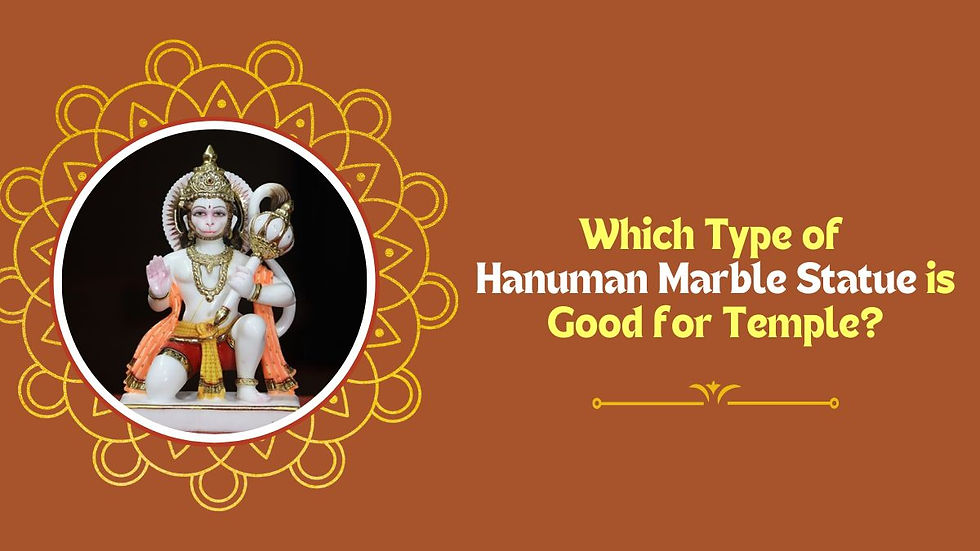Which Type of Hanuman Statue is Good for Temple?
- riddhisiddhimarble
- Aug 14
- 3 min read
Hanuman, the symbol of strength, devotion, and courage, is worshipped in temples across India and beyond. For centuries, devotees have installed Hanuman idols in sacred spaces to invite his blessings, protection from evil, and spiritual strength. But choosing the right Hanuman statue for a temple is more than just picking a beautiful sculpture — it involves understanding traditions, symbolism, and spiritual energy.
One of the most popular choices for temple idols is the Hanuman marble statue from India, celebrated for its purity, craftsmanship, and divine appeal. In this guide, we will explore the different postures and types of Hanuman idols available, and how to select the perfect one for your temple.

Why Marble is Preferred for Hanuman Idols
Marble is regarded as one of the purest and most durable materials for temple statues. A Marble Hanuman Statue carved by skilled artisans not only looks divine but also lasts for generations. Marble remains cool to touch, does not decay, and holds intricate detailing beautifully, making it the first choice for temples.
Rajasthan, especially Jaipur and Makrana, is famous for producing some of the finest Hanuman marble statues from India, where artisans combine traditional methods with deep devotion to create sacred masterpieces.
Popular Postures of Hanuman Marble Statues for Temples
Hanuman is depicted in several forms, each with its own spiritual significance. Here are the most common postures you’ll find:
1. Veer Hanuman (Standing with Gada)
This is one of the most widely installed forms in temples. Hanuman stands upright, holding a gada (mace), symbolizing power, protection, and readiness to defend devotees from negative forces.
2. Bhakt Hanuman (Kneeling in Prayer)
In this posture, Hanuman is shown kneeling with folded hands, gazing towards Lord Rama. This Hanuman marble murti represents humility, devotion, and surrender to God — perfect for temples that emphasize the path of bhakti (devotion).
3. Flying Hanuman (Carrying the Sanjeevani Mountain)
This posture captures the moment Hanuman flew across the skies carrying the Sanjeevani mountain to save Lakshmana’s life. It symbolizes determination, loyalty, and miraculous power. Temples that focus on healing or overcoming obstacles often choose this idol.
4. Panchmukhi Hanuman (Five-Faced Form)
A unique and powerful depiction where Hanuman has five faces — Hanuman, Narasimha, Garuda, Varaha, and Hayagriva — each representing different divine energies. This form is believed to protect from all directions and is considered highly auspicious for temples.
5. Hanuman with Open Heart (Revealing Rama & Sita)
In this form, Hanuman tears open his chest to reveal the images of Lord Rama and Goddess Sita in his heart, symbolizing pure devotion. This Marble Hanuman moorti is an emotional representation of unwavering love and loyalty.
Choosing the Right Hanuman Idol for a Temple
When selecting a Hanuman marble statue from India, consider these factors:
Temple’s Purpose – For protection and strength, choose Veer Hanuman; for devotion, opt for Bhakt Hanuman; for healing, go for Flying Hanuman.
Size & Proportion – The idol’s size should match the temple’s dimensions.
Facial Expression – Hanuman’s eyes should radiate compassion, courage, and divine power.
Vastu Shastra Placement – Ideally, Hanuman idols face north or east, and placing them in the south direction is believed to protect the premises.
Types of Hanuman Marble Statues Available in India
Based on artistic style and detailing, Hanuman marble statues from India come in different types:
Plain White Marble Hanuman – Pure and serene, often chosen for its simplicity.
Painted Marble Hanuman – Hand-painted with natural colors for a vibrant, lifelike appearance.
Gold-Accented Hanuman – Features gold leaf work for a royal, divine look.
Antique-Finish Marble Hanuman – Designed to resemble aged idols with a heritage touch.
Maintenance Tips for Marble Hanuman Idols
A marble idol is easy to maintain but requires gentle care to keep it shining:
Use a soft, damp cloth for cleaning.
Avoid acidic cleaners to prevent surface damage.
Apply sandalwood paste or tilak only in recommended areas to avoid stains.
Final Thoughts
A temple’s Hanuman idol is not just a sculpture — it is the heart of worship, the embodiment of divine strength and devotion. Whether you choose Veer Hanuman, Bhakt Hanuman, or Panchmukhi Hanuman, a finely crafted Hanuman marble statue from India will radiate spiritual energy and inspire generations of devotees.
The right Hanuman marble murti will not only enhance the temple’s spiritual ambiance but also serve as a symbol of protection and blessings. When tradition, artistry, and devotion come together, the result is more than an idol — it’s a living presence of Lord Hanuman in the temple.







Comments